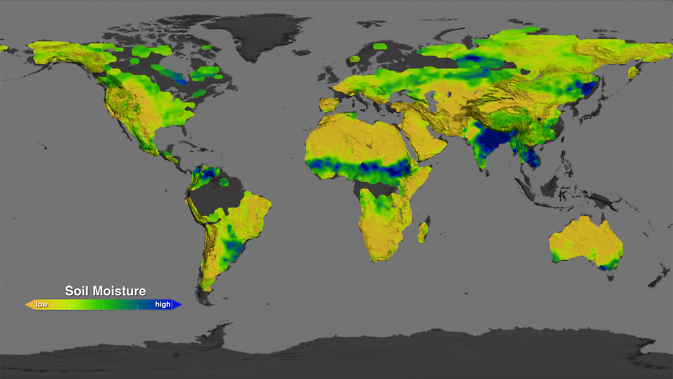Scientists working with data from NASA's Aquarius instrument have released worldwide maps of soil moisture, showing how the wetness of the land fluctuates with the seasons and weather phenomena.
Soil moisture, the water contained within soil particles, is an important player in Earth's water cycle. It is essential for plant life and influences weather and climate. Satellite readings of soil moisture will help scientists better understand the climate system and have potential for a wide range of applications, from advancing climate models, weather forecasts, drought monitoring and flood prediction to informing water management decisions and aiding in predictions of agricultural productivity.
Launched June 10, 2011, aboard the Argentinian spacecraft Aquarius/Satélite de Aplicaciones Científicas (SAC)-D, Aquarius was built to study the salt content of ocean surface waters. The new soil wetness measurements were not in the mission's primary science objectives, but a NASA-funded team led by U.S. Department of Agriculture (USDA) researchers has developed a method to retrieve soil moisture data from the instrument's microwave radiometer.
The Aquarius measurements are considerably coarser in spatial resolution than the measurements from the upcoming NASA Soil Moisture Active Passive (SMAP) mission, which was specifically designed to provide the highest-quality soil moisture measurements available, including a spatial resolution 10 times that offered by Aquarius.
Soils naturally radiate microwaves and the Aquarius sensor can detect the microwave signal from the top 2 inches (5 centimeters) of the land, a signal that subtly varies with changes in the wetness of the soil. Aquarius takes eight days to complete each worldwide survey of soil moisture, although with gaps in mountainous or vegetated terrain where the microwave signal becomes difficult to interpret.
 This image shows what the soil moisture conditions around the planet were like in August 2013: dry areas are represented in the brown scale, while wetter areas are in blue and green. Image Credit: NASA Goddard's Science Visualization Studio/T. Schindler This image shows what the soil moisture conditions around the planet were like in August 2013: dry areas are represented in the brown scale, while wetter areas are in blue and green. Image Credit: NASA Goddard's Science Visualization Studio/T. Schindler
|
Tom Jackson, principal investigator for the Aquarius soil moisture measurements and a hydrologist with USDA, said that his agency uses soil wetness information to improve crop forecasts. These forecasts not only help farmers and markets adjust their prices according to worldwide production, but also allow relief agencies to plan for food emergency responses.
"There's a lot of precipitation data in our country, but outside the U.S. and Europe it gets pretty sparse," said Jackson. "By using soil moisture readings, we can better monitor the condition of soils."
|
This animated version of Aquarius' measurements reveals a dynamic pattern of worldwide shifts between dry and moist soils. Image Credit: NASA's Goddard Space Flight Center |
An animated version of Aquarius' soil moisture measurements reveals a dynamic pattern of worldwide shifts between dry and moist soils. A look at the Eastern coast of Australia during late January and early February 2012 shows the impact of Cyclone Jasmine, a tropical storm that brought heavy rainfall to northern Queensland. In Africa, a wide band of wet soils that matches the rain belt travels north of the equator in the Southern Hemisphere’s winter and then moves south as summer progresses. The land-soaking effects of the monsoon are evident in the Indian subcontinent from June to October. The U.S. Midwest dramatically shifts from being bone-dry during the 2012 drought to waterlogged during the floods of April and May 2013.
But Aquarius has some limitations in its soil moisture estimates, said USDA’s Rajat Bindlish, a co-investigator on the soil moisture maps. The instrument's 62-mile-wide (100-km) footprint prevents it from covering small islands, coastlines and any piece of land narrower than 62 miles, such as Baja California or Italy. Other factors interfere with soil moisture retrievals, too: The dense tree canopy of the Amazon rainforest distorts the microwave signal while snow and ice block it. These areas where the microwave signals are difficult to interpret are shown in dark gray in the Aquarius soil moisture animation.
Aquarius soil moisture data are coarser than those collected by the European Space Agency's Soil Moisture and Ocean Salinity (SMOS) mission. Still, having multiple missions in orbit that simultaneously measure the wetness of the land in the same band of the microwave spectrum ensures a more continuous record, said Peggy O'Neill, of NASA's Goddard Space Flight Center in Greenbelt, Maryland, a co-investigator of the soil moisture project and deputy project scientist of NASA's upcoming soil moisture mission, SMAP.
"One of the things that having Aquarius and SMOS in orbit before SMAP has allowed us to do is to do inter-comparison studies between the sensors," O'Neill said. "By having the three instruments up there at the same time, we will be able to create a long-time series of soil moisture that starts with SMOS and continues with Aquarius and then SMAP. We won't have to worry that the earlier data were taken by SMOS and the later data by SMAP – we'll know they're telling us the same thing. If we hadn't been able to do inter-comparison studies and there had been no overlap between the three instruments, we wouldn’t know how to merge the measurements together."
SMAP, set to launch in November 2014, will advance soil moisture studies with its greater spatial and temporal resolution. The new mission will combine microwave radiometer readings, which are accurate but coarse, with the measurements taken by its onboard radar, which are less precise but have higher spatial resolution than the radiometer data. This approach will provide a footprint of 5.6 miles (9 kilometers), and it will produce worldwide soil moisture maps every three days. Taken together these features of SMAP will provide about 500 times the number of soil moisture measurements per day compared to SMOS or Aquarius.
"Weather and climate models now need information in the 10-kilometer scale," O'Neill said. "SMAP will also allow professionals who now do drought monitoring and flood forecasting at the county level to be able to do it at sub-county levels."
The Aquarius mission and radar were developed at NASA’s Jet Propulsion Laboratory in Pasadena, California, and the radiometer was developed at NASA’s Goddard Space Flight Center. The Aquarius soil moisture product and sea surface salinity measurements are produced by NASA's Goddard Space Flight Center, which manages the mission. Soil moisture data from NASA's Aquarius microwave radiometer are now available at the National Snow and Ice Data Center.






Post a comment
Report Abusive Comment